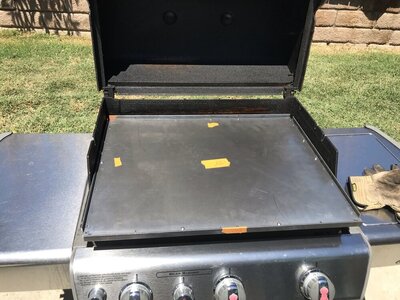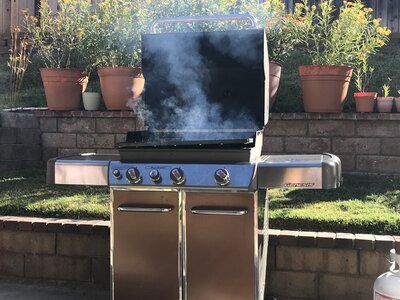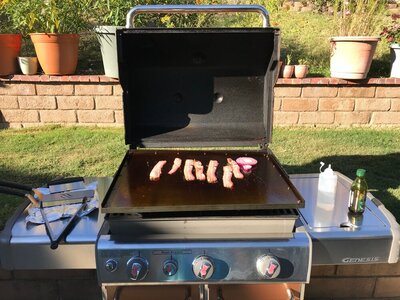I am thinking about building my own flattop griddle instead of buying a new Blackstone. Has anyone here done such a thing? I am thinking I can pop the rack out of my grill and drop in a custom built flattop, or do a standalone. I'm weary of cooking on a piece of sheet steel I buy from a steel yard, and my stainless metalwork skills are non-existent...
Flattop Griddle
- Thread starter winsa12
- Start date
-
Some of the links on this forum allow SMF, at no cost to you, to earn a small commission when you click through and make a purchase. Let me know if you have any questions about this.
You are using an out of date browser. It may not display this or other websites correctly.
You should upgrade or use an alternative browser.
You should upgrade or use an alternative browser.
SmokingMeatForums.com is reader supported and as an Amazon Associate, we may earn commissions from qualifying purchases.
Have not built my own but use one of these for camping:

 www.campchef.com
Have a few different sizes and maybe some of the pictures can help with your design.
www.campchef.com
Have a few different sizes and maybe some of the pictures can help with your design.

Griddle 16 - 3 Burner and More | Camp Chef
This huge restaurant style Professional Flat Top Griddle is big enough to cook for almost any crowd.
- Jan 16, 2019
- 388
- 452
Yup, I did it about 2 months before I bought a Blackstone. It was a fun project and it actually worked pretty well on my Weber gasser.





Couple things I learned:
I used a piece of, I think cold rolled steel that was something like 10 gauge (don't remember). Since I don't have a welder, I drilled and bolted the sides on. In retrospect, I would have used thicker material. This heats fast, but doesn't hold the heat.
The steel I used did not have alot of scale on it so I took my grinder and put a flat disc on it and took it down to shiny metal, then sanded it smooth. That worked great. Light pressure on the grinder so you don't dig grooves.
I should have used higher sides.
If you have a welder, it might be beneficial to weld some braces on the bottom. I do get some warpage with heating, cooling and cleaning, as you can see.
There is no grease containment system on this so it can get messy.
I experimented on height above the grate and finally settled on about 3/4 inch. It is up on ceramic BBQ briquettes and that works well, BUT I did have to trim it down about an inch all the way around so the heat has somewhere to go. Otherwise it all comes out the front and you end up with a very hot belly.
If you do this, spend extra time seasoning it. It is a much different surface than a Blackstone so a little extra time will be needed.
All in all, it was a fun project and it worked well. But it is heavy and hard to store when not in use so I ended up with a Blackstone 28 Pro. Love the Blackstone and they are starting to show up on clearance at Walmart and Lowes.....
If you do make one, post pics and how you like it!





Couple things I learned:
I used a piece of, I think cold rolled steel that was something like 10 gauge (don't remember). Since I don't have a welder, I drilled and bolted the sides on. In retrospect, I would have used thicker material. This heats fast, but doesn't hold the heat.
The steel I used did not have alot of scale on it so I took my grinder and put a flat disc on it and took it down to shiny metal, then sanded it smooth. That worked great. Light pressure on the grinder so you don't dig grooves.
I should have used higher sides.
If you have a welder, it might be beneficial to weld some braces on the bottom. I do get some warpage with heating, cooling and cleaning, as you can see.
There is no grease containment system on this so it can get messy.
I experimented on height above the grate and finally settled on about 3/4 inch. It is up on ceramic BBQ briquettes and that works well, BUT I did have to trim it down about an inch all the way around so the heat has somewhere to go. Otherwise it all comes out the front and you end up with a very hot belly.
If you do this, spend extra time seasoning it. It is a much different surface than a Blackstone so a little extra time will be needed.
All in all, it was a fun project and it worked well. But it is heavy and hard to store when not in use so I ended up with a Blackstone 28 Pro. Love the Blackstone and they are starting to show up on clearance at Walmart and Lowes.....
If you do make one, post pics and how you like it!
I was thinking the same, grease management would be an issue. Unless you just want a project I would go straight to a blackstone.
I have a smaller version of the Camp Chef griddle that
B
BigW.
posted, and on the backside is a heat diverter of sorts. Mine is used on a Camp Chef stove so the diverter is for balancing the heat. And the griddle is heavy enough I have not had any warpage issues.
If you fabricate your own, one thing I would worry about if you just used plate steel would be warpage if you went too thin. A stiffener on the backside might control warpage.
If you fabricate your own, one thing I would worry about if you just used plate steel would be warpage if you went too thin. A stiffener on the backside might control warpage.
fltsfshr
Smoking Fanatic
- Sep 8, 2015
- 411
- 696
Here's a trick I learned. Go to a used restaurant supply house not online. Pick out a griddle you can work with. Lots of places have gone out of business. Take it home and change the jets out from natural gas to propane.
bill1
Master of the Pit
- Apr 25, 2015
- 1,963
- 925
Just got a 3-burner, 27"-wide propane griddle, with hinged lid, from Walmart ("Expert Grill" brand) for $184. Couldn't be happier with it.
It's a pretty hefty piece of cast iron, but still has ribs welded underneath to keep it from warping. It has a nice grease drain at the right front, but now that it's well-seasoned, and I'm getting some skill using it, I'm not generating that much oil waste with it so not having a drain isn't necessarily a show-stopper for a griddle going on a gas grill. Either way, you're committing to smuggle a dirty rag (I like old washcloths) into the laundry pretty much each time you use it.
But I do recommend avoiding something small. Mine's 27x15 and I'm usually using it for just MY breakfast and I consider it just the right size. I suppose as I get better with it I could use a smaller surface but it's no fun starting out cramped.
I mounted the bottle underneath the unit so it only uses 28" of patio space. The wife seems cool with it. It followed me home while she was out of town.
It's a pretty hefty piece of cast iron, but still has ribs welded underneath to keep it from warping. It has a nice grease drain at the right front, but now that it's well-seasoned, and I'm getting some skill using it, I'm not generating that much oil waste with it so not having a drain isn't necessarily a show-stopper for a griddle going on a gas grill. Either way, you're committing to smuggle a dirty rag (I like old washcloths) into the laundry pretty much each time you use it.
But I do recommend avoiding something small. Mine's 27x15 and I'm usually using it for just MY breakfast and I consider it just the right size. I suppose as I get better with it I could use a smaller surface but it's no fun starting out cramped.
I mounted the bottle underneath the unit so it only uses 28" of patio space. The wife seems cool with it. It followed me home while she was out of town.
You end up deciding to do this? Let us know if you do....think I'm gonna try the same thing.I am thinking about building my own flattop griddle instead of buying a new Blackstone. Has anyone here done such a thing? I am thinking I can pop the rack out of my grill and drop in a custom built flattop, or do a standalone. I'm weary of cooking on a piece of sheet steel I buy from a steel yard, and my stainless metalwork skills are non-existent...
bill1
Master of the Pit
- Apr 25, 2015
- 1,963
- 925
If you've got the space, there's nothing like a dedicated tool. And we're heading into the time of the year when the great sales show up on our kinds of toys.....think I'm gonna try the same thing.
There are also nice griddle options specifically intended for gas grills. E.g. www.amazon.com/Camp-Chef-SG60-Professional-Seasoned/dp/B0000AQO12
But ya' know, unless you're giving up on grilling, you still need a place to store it. And seasoned cast iron needs to kept dry and clean. The Blackstone-like products (with a lid, a huge must in my book) take care of all that for you.
If you decide to take a leap at making one the steel of choice will be "pickled and oiled steel" AKA: P&O steel) from an actual metals distributor. Most steel is "hot rolled" and has a layer of mill scale you'll want to remove before cooking directly on it.
Pickled and oiled steel has been bathed in acid to remove the mill scale and oiled to prevent rust. It has a smooth surface and all you need to do is clean off the preservative oil and wash it with dish soap and water, dry it well and oil it with food grade oil.
The size you're looking for is often considered a "drop" and if you call around steel suppliers and fabrication shops you may find some relatively inexpensively. If there is an "ALRO Outlet" nearby they can be a good resource for all kinds of smaller pieces and/or scratch and dent pieces that you can cut good hunks out of.metals, structual plastics such as Delrin and nylon etc.
You can season bare steel similar to cast iron.
Lance
Pickled and oiled steel has been bathed in acid to remove the mill scale and oiled to prevent rust. It has a smooth surface and all you need to do is clean off the preservative oil and wash it with dish soap and water, dry it well and oil it with food grade oil.
The size you're looking for is often considered a "drop" and if you call around steel suppliers and fabrication shops you may find some relatively inexpensively. If there is an "ALRO Outlet" nearby they can be a good resource for all kinds of smaller pieces and/or scratch and dent pieces that you can cut good hunks out of.metals, structual plastics such as Delrin and nylon etc.
You can season bare steel similar to cast iron.
Lance
Very good to know!! Yeah I was planning on bathing it in vinegar for that purpose, but good to know you can get that P&O stuff right off the bat. Just season with beef tallow afterward...correct? I know some people you linseed, but I'm not sure how that affects taste...If you decide to take a leap at making one the steel of choice will be "pickled and oiled steel" AKA: P&O steel) from an actual metals distributor. Most steel is "hot rolled" and has a layer of mill scale you'll want to remove before cooking directly on it.
Pickled and oiled steel has been bathed in acid to remove the mill scale and oiled to prevent rust. It has a smooth surface and all you need to do is clean off the preservative oil and wash it with dish soap and water, dry it well and oil it with food grade oil.
The size you're looking for is often considered a "drop" and if you call around steel suppliers and fabrication shops you may find some relatively inexpensively. If there is an "ALRO Outlet" nearby they can be a good resource for all kinds of smaller pieces and/or scratch and dent pieces that you can cut good hunks out of.metals, structual plastics such as Delrin and nylon etc.
You can season bare steel similar to cast iron.
Lance
I don't know. I've never made anything to cook directly on.Just season with beef tallow afterward...correct? I know some people you linseed, but I'm not sure how that affects taste...
I prefer P&O steel for projects when I can get it without having heart palpitations over the price as it nearly tripled over the last four or so years. But at the moment I still have 2-2/3 four by eight foot sheets of hot rolled 1/4" steel and by the time I use that up maybe 1/4" P&O will be out of the nosebleed range.
Lance
Thanks all, lot to think about. I kind of want a project, and I didn’t ever know about P and O steel. I really liked my few year old blackstone with a lid. I can’t find one used, so I’ll take a look at sales.
radioguy
Master of the Pit
Get a thick piece of steel, 1/4" or thicker. Try looking around scrap yards. I've gotten some good plate from the local junk dealers. Weld some small angle iron on the bottom, X corner to corner. That will stop warping.
FYI, just bought a 22" blackstone 1813 with lid Amazon used/return $158.
RG
FYI, just bought a 22" blackstone 1813 with lid Amazon used/return $158.
RG
Last edited:
bill1
Master of the Pit
- Apr 25, 2015
- 1,963
- 925
I season with the same cheap canola oil I cook with. Like with cast iron, this is really a varnishing step to prevent rust and make the surface slippery (so food doesn't stick). The heat and O2 polymerizes the carbon chains of the oil into sheets of higher melt point. A rule of thumb is to go to about 50F over your seasoning oil's smoke point. Yes, some of the carbons are being lost to soot/smoke off the top layer, but you're also getting some bonding to the carbons in the steel....Just season with beef tallow afterward...correct? I know some people you linseed, but I'm not sure how that affects taste...
Which is an argument for starting with high-carbon steel. Cast iron griddles are hard to beat with a C content at 2-4%, whereas most "carbon steels" can be <.5%. If you were truly case-hardening the steel it wouldn't matter, but I think this is better called varnishing.
Like wood varnish, once it's fully cured (polymerized) it shouldn't smell/taste anymore (your other concern). But that's assuming you don't greatly exceed the temp you cured it at. Some griddles with lids, in summer, on high, can get VERY hot. I try never to exceed 400F.
I always wipe my griddle with a fresh thin coat of canola oil after each use. When I fire it up next time, I close up and wait for the stink of burning oil to just start, then I open it up and add a fresh squeeze of oil (and spread out) before adding foods that can stick or just throw the fatty meats on direct. From that point, the food wicks away enough heat so you can be pretty confident your surface temp is ~375F (a cheap IR meter or flattop thermometer makes it easy to verify) well below the smoke point at which possibly some flavor could be imparted to my food from whatever my even higher melting-point "seasoning" may be at.
Last edited:
SmokingMeatForums.com is reader supported and as an Amazon Associate, we may earn commissions from qualifying purchases.
Similar threads
- Replies
- 28
- Views
- 29K
- Replies
- 11
- Views
- 5K
- Replies
- 9
- Views
- 752
- Replies
- 0
- Views
- 916
- Replies
- 3
- Views
- 844
Hot Threads
-
Dehydrater
- Started by pc farmer
- Replies: 31
- Blowing Smoke Around the Smoker.
-
Pop’s brine scalable?
- Started by curmudgeonly
- Replies: 23
- Info and Practices
-
Just a Simple Breakfast
- Started by BrianGSDTexoma
- Replies: 19
- Breakfast
-
Friday Cocktail Hour. Whatchya Drinkin'?
- Started by Quiganomics
- Replies: 18
- General Discussion





